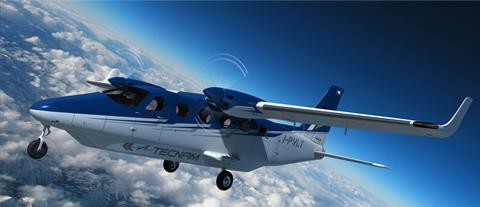Tecnam paused the development of its all-electric P-Volt over fears that battery performance would degrade so quickly that within weeks the nine-passenger aircraft would be reduced to flying routes of under 40nm (74km).
Announcing the move on 13 June, the Italian airframer said that batteries were not sufficiently mature, and their development path so uncertain, that it would not be possible to bring a “viable” product to market by its target of 2026.

“We are convinced that a full-electric passenger airplane can be developed and certified, but the business figures won’t allow us to definitively establish whether the end-user would benefit from that or not,” says Fabio Russo, chief R&D and product development officer for Tecnam.
He says the energy density of cells and their ability to maintain their storage capacity over hundreds of cycles were the two areas of concern.
Tecnam’s analysis suggests that although battery performance is slowly improving, the constraints of aircraft design mean that, at pack level, energy density “will be far below 200Wh/kg”, he says.
Required fireproof battery storage structures and ancillary equipment will further erode the effective power density, he argues, “leading to values that are eventually lower than 180Wh/kg”.
Although automotive batteries can be limited to charge levels of around 80% to maintain their longevity, to do the same for aerospace applications “would mean another massive degradation of mission performance”, says Russo.
Additionally, the need to always operate with a “healthy battery pack” would see these needing to be replaced after “less than 1,000 cycles”.
Tecnam estimates that 10% battery performance degradation would complicate mission planning, as range would decrease by 20% after less than 1,000 cycles – and would drive up operating costs significantly.
Based on its forecasts, Tecnam estimates that with aerospace batteries likely to cost at least $1,500/kWh, an entire 215kWh battery pack suitable for the P-Volt would come in at more than $300,000.
“With these considerations and with our willingness to look at every single aspect of the aircraft design and lifecycle, it could mean that after a few weeks of normal airline operations, the P-Volt could feature a realistic range of less than 40nm, plus [visual flight rules] reserve,” says Russo.
Tecnam had targeted an effective range of 85nm at service entry, already far lower than the 950nm offered by the combustion-engined P2012 Traveller on which the P-Volt is based.
Hydrogen fuel cells offer an alternative powertrain solution, but Russo says the continued uncertainty around their development, particularly relating to weight and certification requirements, does not provide sufficient clarity to justify investment on aircraft development.
Tecnam had progressed deep into the analysis of the likely P-Volt design – and had developed, built and flown a wing optimised for the aircraft. It is hopeful the project can be reanimated at a later stage, says Russo, but this will hinge on factors outside its control.
“Once battery technology is ready, Tecnam will be fast in bringing the P-Volt back to the design, certification and production arena,” he says.
Tecnam was partnered with Rolls-Royce on the P-Volt, which was to provide the aircraft’s electric propulsion units.
“The collaboration between Rolls-Royce and Tecnam on the P-Volt programme has been a key opportunity allowing both companies to fully analyse the electrification roadmap for this platform. The significant market interest clearly demonstrates the market demand for such sustainable solutions,” says the propulsion specialist.
“The results achieved, based on detailed system performance and integration designs, clearly define the capabilities and limitations of this battery-electric configuration.
“While the initial range is sufficient for key applications, energy storage lifecycle performance results in business cases which do not lend themselves to broad market adoption.”
It sees better viability in the sub-regional space provided by hybrid-electric or fuel cell power, with battery-only designs at present confined to urban air mobility applications.
“Evolution of cell technology will continue to shift the boundaries and improve the field of viability for all battery commuter platforms. Rolls-Royce product development for commuter propulsion systems is continuing to power both these and hybrid-electric systems.”
Norwegian regional carrier Wideroe was also involved in the P-Volt project and had hoped to launch services with the type in 2026.
Andreas Aks, chief executive of the airline’s Wideroe Zero unit, states: “In this, as in all our collaborations with our many OEM partners, our role is to research whether new aircraft concepts can be operated in a commercially viable way.
”Although this particular concept didn’t prove viable today, this may change as technology matures. It’s a difficult code to crack, and we appreciate Tecnam’s effort in doing so.”































